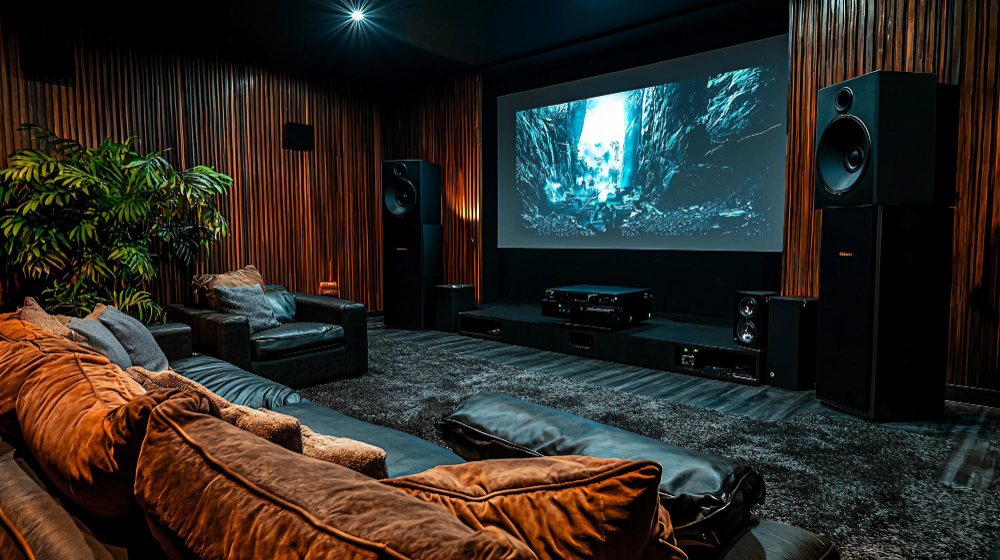To troubleshoot home theater issues, start by addressing common audio problems like lag or distortion, which may stem from speaker placement or incompatible formats. Verify all video resolution settings align with your display’s native capabilities to prevent distortion. Connectivity issues can arise from wireless interference, so adjust router placement and check HDMI connections. For remote control malfunctions, replace batteries and confirm configuration accuracy. Regular maintenance, including cleaning equipment and updating firmware, enhances performance. Implementing these strategies will optimize your system, creating a superior experience. Explore further for additional insights on maximizing your home theater setup.
Common Audio Issues

When setting up a home theater system, users often run into common audio issues that can detract from the overall viewing experience. One prevalent issue is audio lag, where there is a noticeable delay between the video and audio signals. This can occur due to processing delays in external devices like soundbars or receivers, or from using wireless connections.
To rectify this, users should check for any latency settings in the audio output configuration and consider using wired connections for critical components.
Another significant concern is speaker distortion, which can arise from poor speaker placement, incompatible audio formats, or excessive volume levels. Distortion is characterized by a muddled sound that lacks clarity, often resulting from overdriving the speakers beyond their capacity.
Ensuring that speakers are positioned correctly, away from walls, and at ear level can mitigate this issue. Additionally, users should verify that their audio source matches the capabilities of the speakers and adjust the volume to remain within the recommended range.
Employing room calibration tools available in many receivers can also help optimize audio performance, thereby enhancing the overall home theater experience.
Video Display Problems
In the domain of home theater systems, video display problems can considerably undermine the viewing experience.
These issues often stem from incorrect resolution settings or faulty display connections. To troubleshoot effectively, consider the following steps:
- Check Resolution Settings: Confirm that the output resolution from your source device matches the native resolution of your display. Mismatched settings can lead to distorted images or black screens.
- Inspect Display Connections: Verify that all cables connecting your source device to the display are secure and undamaged. Loose or frayed HDMI or component cables can result in signal loss, causing visual artifacts or a complete lack of signal.
- Adjust Display Settings: Access the display menu to confirm that the input source is correctly selected and that any necessary features, such as HDR or scaling options, are enabled. An incorrect setting can prevent ideal display performance.
Connectivity Troubles
Connectivity troubles can arise unexpectedly, disrupting the seamless operation of a home theater system. A common issue is wireless interference, which can severely impact the performance of devices relying on Wi-Fi or Bluetooth connectivity. Sources of interference include microwaves, cordless phones, and neighboring Wi-Fi networks.
To mitigate this, consider relocating your router or switching to a less congested frequency band, such as 5 GHz, if your equipment supports it.
Another frequent connectivity challenge is related to HDMI handshake failures. The HDMI handshake is a communication protocol that establishes connection parameters between devices, such as resolution and audio formats. If devices fail to recognize each other, the result can be a blank screen or audio dropouts.
To resolve this, start by ensuring all HDMI cables are securely connected and are of high quality. If problems persist, try powering down all devices, unplugging them, and then reconnecting them in the correct sequence—typically starting with the source device, followed by the display.
Additionally, updating firmware on devices can help resolve compatibility issues that may affect HDMI handshakes, ensuring stable connections across your home theater setup.
Remote Control Malfunctions
Wireless connectivity issues can often lead to unexpected challenges, and one area frequently affected is the remote control functionality within a home theater system.
Malfunctions in remote controls can stem from various sources, including dead batteries, interference from other devices, or configuration errors. Addressing these issues promptly can restore seamless operation and enhance the user experience.
To troubleshoot remote control malfunctions effectively, consider the following steps:
- Check Battery Status: Verify that the batteries in the remote are fully charged and correctly installed. Replace them if necessary.
- Reduce Interference: Identify and eliminate potential sources of interference, such as other wireless devices or physical obstructions between the remote and the components.
- Explore Remote Replacement Options: If malfunctions persist, consider universal remotes as a viable solution. These remotes can control multiple devices, simplifying your setup while providing reliable functionality.
Overheating Equipment Solutions
Overheating is a common issue that can greatly impact the performance and longevity of home theater equipment. Effective solutions involve implementing proper cooling systems and ventilation solutions to maintain ideal operating temperatures. Here are some strategies to take into account:
| Solution | Description | Benefits |
|---|---|---|
| Active Cooling | Use fans or liquid cooling systems to dissipate heat. | Enhances performance and reliability. |
| Passive Cooling | Incorporate heat sinks or thermal pads in design. | Reduces reliance on active components, lowering noise. |
| Ventilation Design | Guarantee adequate airflow around equipment by using racks with open designs. | Improves heat dissipation, preventing hotspots. |
| Environmental Control | Maintain room temperature with air conditioning or fans. | Guarantees a stable environment for all components. |
Implementing these solutions can notably reduce the risk of overheating, prolonging the life of your home theater system. Regular maintenance checks, such as cleaning dust from vents and guaranteeing unobstructed airflow, are also essential to the effectiveness of these cooling systems. By proactively addressing overheating issues, you can enjoy a seamless viewing experience without interruptions.
Network Streaming Errors
Streaming videos in high definition can be a frustrating experience when faced with network streaming errors. These errors often manifest as buffering issues, greatly disrupting your viewing experience.
To address these concerns, it is crucial to understand the elements that affect streaming speed and how to optimize your network for seamless playback.
- Check Your Internet Speed: Confirm that your internet connection meets the recommended bandwidth for HD streaming, typically around 5 Mbps for standard HD and 25 Mbps for 4K content. Use an online speed test to verify your current speed.
- Optimize Your Router Placement: The location of your router can impact streaming performance. Place your router in a central position within your home and away from obstructions to improve signal strength.
- Limit Network Traffic: Too many devices connected to your network can reduce available bandwidth, leading to buffering issues. Disconnect unnecessary devices or consider upgrading your internet plan to accommodate multiple users.
Calibration and Setup Tips
Proper calibration and setup of your home theater system are vital for achieving ideal audio and visual performance, as even the most advanced equipment can underperform without precise configuration.
Begin by evaluating your room acoustics, as they considerably influence sound quality. Hard surfaces can create echoes, while soft furnishings can absorb sound and reduce clarity. Utilize acoustic panels or bass traps to enhance the auditory experience.
Next, focus on speaker placement, which is essential for optimal sound staging. Position the front speakers equidistant from the listening area, ideally forming a 30-degree angle with the listener’s position. Subwoofers should be placed strategically to minimize phase issues; experimentation may be necessary to find the best location. Surround speakers should be mounted slightly above ear level and placed to the side or slightly behind the listening position.
Following speaker placement, utilize an audio calibration tool, if available, to adjust levels and equalization settings. This can help compensate for room anomalies and guarantee a balanced sound field.
Finally, verify that your video display is calibrated for color accuracy and brightness, utilizing built-in settings or professional calibration tools to enhance your home theater experience.
Cable Management Solutions
Effective cable management is essential for maintaining an organized and aesthetically pleasing home theater setup. Proper cable organization not only enhances the visual appeal but also improves functionality, making it easier to troubleshoot any connectivity issues.
Here are three effective solutions for wire concealment:
- Cable Sleeves: These flexible tubes allow you to bundle multiple cables together, providing a streamlined look. They can be cut to the desired length and are available in various materials, including fabric and plastic, ensuring they can fit any décor.
- Wall Plates and Raceways: Installing wall plates and raceways enables you to route cables through the walls, keeping them hidden from view. This solution minimizes clutter and allows for easy access to connections while maintaining a clean appearance.
- Cable Clips and Ties: Utilizing adhesive cable clips or reusable cable ties can help secure cables along walls or furniture edges. This simple method prevents tangling and keeps cables neatly aligned, ensuring your home theater setup remains tidy.
Implementing these cable management solutions will not only enhance your home theater’s aesthetics but also contribute to its overall efficiency and performance.
Preventative Maintenance Tips
Maintaining the performance of a home theater system is fundamental for guaranteeing ideal viewing and listening experiences. Regular preventative maintenance can markedly extend the lifespan of your equipment and enhance its functionality.
Start by cleaning equipment routinely to prevent dust accumulation, which can hinder performance. Use a soft microfiber cloth for screens and a vacuum with a brush attachment for speakers, confirming that you do not damage delicate components. Avoid using harsh chemicals; instead, opt for specialized electronic cleaning solutions.
Additionally, it is important to check connections periodically. Loose or corroded connections can lead to audio and video issues. Inspect HDMI, audio, and power cables for wear and verify they are securely connected to their respective devices. Consider using cable ties for organization and to prevent strain on connectors.
Another significant aspect of maintenance involves keeping your system’s firmware updated. Manufacturers often release updates that enhance performance and fix bugs.
Finally, verify the room is well-ventilated to prevent overheating, which can negatively impact equipment longevity. By following these preventative maintenance tips, you can enjoy a consistently high-quality home theater experience.
Frequently Asked Questions
How Can I Enhance My Home Theater’s Overall Sound Quality?
To enhance your home theater’s overall sound quality, implement soundproofing techniques to minimize external noise interference. Additionally, perform audio calibration to optimize speaker placement and settings, ensuring a balanced and immersive listening experience tailored to your environment.
What Are the Best Speaker Placement Strategies for Surround Sound?
To achieve an immersive auditory experience, ideal speaker positioning is essential. Arrange surround sound speakers at ear level, forming a semicircle around the listening area, ensuring balanced sound distribution and enhancing the overall cinematic atmosphere.
How Do I Choose the Right Screen Size for My Room?
To select the appropriate screen size, consider room dimensions and viewing distance. A general guideline is to choose a screen that is approximately one-third the distance from the seating area, ensuring ideal viewing experience and comfort.
Are There Specific Brands Recommended for Home Theater Components?
When selecting home theater components, prioritize brand reliability and guarantee component compatibility. Recommended brands include Sony, Denon, and Marantz, known for their performance and integration, which greatly enhances the overall viewing experience in home entertainment systems.
How Often Should I Update My Home Theater Equipment?
Consider updating your home theater equipment every three to five years to guarantee peak performance and compatibility with emerging technologies. This upgrade frequency balances equipment longevity with advancements, enhancing your viewing experience while avoiding obsolescence.
Conclusion
To sum up, effective troubleshooting of home theater systems necessitates a systematic approach to identify and rectify common issues such as audio malfunctions, connectivity problems, and overheating. By implementing proper calibration techniques and ensuring ideal cable management, the longevity and performance of equipment can be enhanced. Can a well-maintained home theater system not only elevate the viewing experience but also provide lasting enjoyment? Adopting preventative maintenance practices will certainly contribute to sustained functionality and satisfaction.





